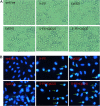CpG oligodeoxynucleotides enhance chemosensitivity of 5-fluorouracil in HepG2 human hepatoma cells via downregulation of the antiapoptotic factors survivin and livin
- PMID: 24161202
- PMCID: PMC4176997
- DOI: 10.1186/1475-2867-13-106
CpG oligodeoxynucleotides enhance chemosensitivity of 5-fluorouracil in HepG2 human hepatoma cells via downregulation of the antiapoptotic factors survivin and livin
Abstract
Background: Recent studies indicated that a synthetic oligonucleotide containing un-methylated CpG oligodeoxynucleotides (CpG-ODN) has a potential function for cancer therapy. In this study, we evaluated the chemosensitizing effects of CpG-ODN in 5-fluorouracil (5-FU)-treated HepG2 human hepatoma cells.
Methods: Cell viability assay were utilized to evaluate the direct cytotoxicity of CpG-ODN in the presence or absence of 5-FU in HepG2 cells, and apoptosis as well as cell-cycle was examined by flow cytometry analysis. The mRNA expression of Bcl-2, Livin and Survivin within HepG2 cells treated with CpG-ODN and/or 5-FU were analyzed by Real Time PCR assay in vitro.
Results: CpG-ODN in combination with 5-FU could decrease cell viability, increase apoptosis and further induce HepG2 cells cycle arrest at S phase when compared with CpG-ODN or 5-FU. CpG-ODN or 5-FU could down-regulate the mRNA expression of Bcl-2 within HepG2 cells. The mRNA expression of Livin and Survivin decreased in cells treated with CpG-ODN alone but increased in cells treated with 5-FU alone. However, CpG-ODN in combination with 5-FU could down-regulate the mRNA expression of Livin and Survivin within HepG2 cells.
Conclusions: Our finding demonstrated that CpG-ODN enhanced the chemosentivity of 5-FU in HepG2 human hepatoma cells at least in part by down-regulating the expression of Livin and Survivin, leading to apoptosis and further inducing cell cycle arrest at S phase. Therefore, CpG-ODN may be a potential candidate as chemosensitizer for human hepatocellular carcinoma.
Figures





References
-
- Subramaniam A, Shanmugam MK, Perumal E, Li F, Nachiyappan A, Dai X, Swamy SN, Ahn KS, Kumar AP, Tan BK. et al.Potential role of signal transducer and activator of transcription (STAT)3 signaling pathway in inflammation, survival, proliferation and invasion of hepatocellular carcinoma. Biochim Biophys Acta. 2013;1835(1):46–60. - PubMed
-
- Damdinsuren B, Nagano H, Monden M. Combined intra-arterial 5-fluorouracil and subcutaneous interferon-alpha therapy for highly advanced hepatocellular carcinoma. Hepatol Res. 2007;37(Suppl 2):S238–S250. - PubMed
-
- Sakabe T, Tsuchiya H, Kanki K, Azumi J, Gonda K, Mizuta Y, Yamada D, Wada H, Shomori K, Nagano H. et al.Identification of the genes chemosensitizing hepatocellular carcinoma cells to interferon-alpha/5-fluorouracil and their clinical significance. PLoS One. 2013;8(2):e56197. doi: 10.1371/journal.pone.0056197. - DOI - PMC - PubMed
LinkOut - more resources
Full Text Sources
Other Literature Sources

